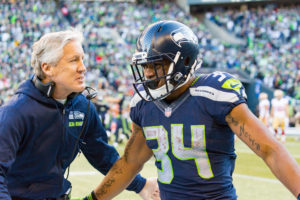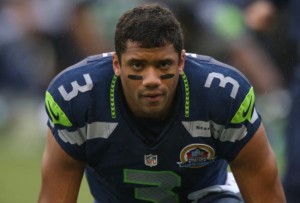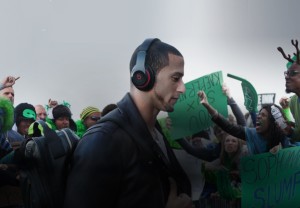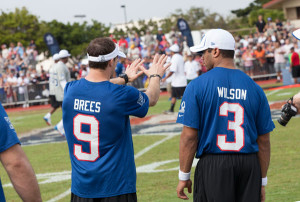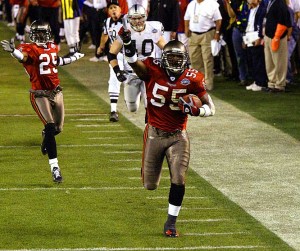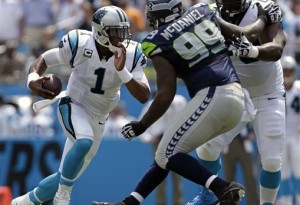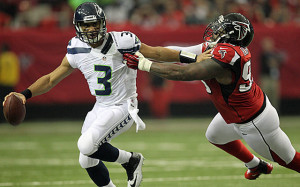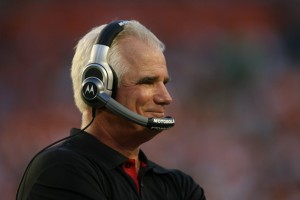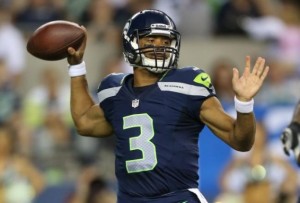In the Super Bowl era, there has been just one team that was both the youngest in the league and one of the five best teams in football: the 2012 Seattle Seahawks. As friend of Football Perspective Neil Paine recently pointed out, being young and great has historically been a good predictor of teams that have become dynasties. Consider the table below. It captures every team since 1966 that ranked amongst the five youngest teams by Approximate Value (AV)-weighted age and had at least 12 Pythagenpat wins, adjusting everything to a 16-game schedule.
| Team | Year | Pyth Wins | AV-wtd age | Age Rank |
| PIT | 1972 | 13.5 | 25.6 | 5 |
| DAL | 1992 | 12.6 | 26.4 | 2 |
| DAL | 1993 | 12.4 | 26.7 | 4 |
| STL | 1999 | 14.2 | 26.6 | 5 |
| CHI | 2001 | 12.4 | 26.5 | 5 |
| SDG | 2006 | 12.6 | 26.5 | 5 |
| IND | 2007 | 12.8 | 26.7 | 4 |
| SEA | 2012 | 12.6 | 25.8 | 1 |
| SEA | 2013 | 13.1 | 26 | 3 |
There are seven unique teams on this list, not counting the two repeaters. When trying to predict what’s going to happen with the Seahawks, there are two different ways to look at this list. The first looks good for their dynasty potential. The first two teams on the list, the ’72 Steelers and the ’92 Cowboys went on to win multiple Super Bowls. The closest comparison in terms of age also looks pretty good. Teams used to be younger, so the best comparison probably isn’t the ’72 Steelers, who were even younger by age but were only the fifth-youngest team in 1972, but the ’92-’93 Cowboys. They are the only other team on this list to be so young and so good.
Of course, even the Cowboys had a pretty short run. Their stay at the top was nothing like the ’70s Steelers or ’80s Niners, who were also quite young. Free agency helped to minimize their time on top. The ’90s Cowboys were the first great team in the free agency era. Players gained full freedom of movement only in the year after their first Super Bowl. Plan B free agency allowed limited movement starting in 1989.
Free agency and the salary cap help to explain the path of the other four teams on the list. They point towards a more cautious prediction about the Seahawks’ dynasty hopes. Between them, the ’99 Rams, ’01 Bears, ’06 Chargers, and ’07 Colts won one Super Bowl and played in two others. Within three years of their great-and-young season, only the Chargers were significantly better than league-average.
These more recent examples may do a better job of predicting the Seahawks future success. Before the beginning of full free agency in 1993, good-and-relatively-young teams appear to have generally followed a clear and sustained upwards trajectory over the long term. Since then, however, success has generally been less sustainable. The table below looks at teams’ strengths over time according to PFR’s Simple Rating System. Here I’ve made the cutoff any team that was in the five youngest teams in a given year and also had a SRS rating of at least 6. The table shows the trend in strength for the previous season and the following three seasons.
| Team | Year | SRS (t-1) | SRS (t) | SRS (t+1) | SRS (t+2) | SRS Wins (t+3) | AV-wtd age | Age Rank |
| PIT | 1972 | -3.6 | 10 | 8.2 | 6.8 | 14.2 | 25.6 | 5 |
| BAL | 1975 | -8.7 | 8.6 | 9.8 | 5 | -8.8 | 25.9 | 5 |
| SFO | 1981 | -6.2 | 6.2 | -2.4 | 8.7 | 12.7 | 25.8 | 3 |
| NOR | 1987 | 0 | 10.1 | 1.5 | 4.6 | -1.3 | 26 | 4 |
| DAL | 1992 | 4.4 | 9.9 | 9.6 | 10.1 | 9.7 | 26.4 | 2 |
| Average | | -2.82 | 8.96 | 5.34 | 7.04 | 5.3 | 25.94 | 3.8 |
| Team | Year | SRS (t-1) | SRS (t) | SRS (t+1) | SRS (t+2) | SRS (t+3) | AV-wtd age | Age Rank |
| DAL | 1993 | 9.9 | 9.6 | 10.1 | 9.7 | 2.4 | 26.7 | 4 |
| IND | 1999 | -5.4 | 6.1 | 7.9 | -3.8 | 1.2 | 25.6 | 1 |
| STL | 1999 | -2.3 | 11.9 | 3.1 | 13.4 | -3.3 | 26.6 | 5 |
| IND | 2000 | 6.1 | 7.9 | -3.8 | 1.2 | 7 | 26.3 | 3 |
| CHI | 2001 | -6.3 | 7.9 | -5.3 | -3.5 | -8.2 | 26.5 | 5 |
| BAL | 2003 | -2.1 | 6.3 | 6.1 | -1.8 | 9.3 | 26.4 | 3 |
| IND | 2003 | 1.2 | 7 | 11.4 | 10.8 | 5.9 | 26.5 | 4 |
| SDG | 2004 | -6.8 | 9.1 | 9.9 | 10.2 | 8.8 | 26.5 | 2 |
| BAL | 2004 | 6.3 | 6.1 | -1.8 | 9.3 | -6.7 | 26.7 | 3 |
| SDG | 2005 | 9.1 | 9.9 | 10.2 | 8.8 | 5 | 26.8 | 5 |
| JAX | 2006 | 4.8 | 7.5 | 6.8 | -2.5 | -6.5 | 26.5 | 2 |
| SDG | 2006 | 9.9 | 10.2 | 8.8 | 5 | 6.6 | 26.5 | 5 |
| SDG | 2007 | 10.2 | 8.8 | 5 | 6.6 | 4.8 | 26.4 | 2 |
| IND | 2007 | 5.9 | 12 | 6.5 | 5.9 | 2.9 | 26.7 | 4 |
| SEA | 2012 | 0.8 | 12.2 | 13 | | | 25.8 | 1 |
| SEA | 2013 | 12.2 | 13 | | | | 26 | 3 |
| Average | | 3.34 | 9.09 | 5.86 | 4.95 | 2.09 | 26.41 | 3.25 |
One surprising pattern in these data is just how infrequently young teams won in the past. From 1966-1992, only five teams were among the five youngest and still had an SRS of at least 6. Since 1993, it’s happened 16 times. In the past, teams had more of an opportunity to gradually build strength. So it looks like there was a greater share of young teams building for something and old teams trying to stay on top. Since 1993, the standard deviation of team ages is about 20% smaller than it was before that. In the last ten years, the standard deviation is about 30% smaller than it was before 1993. The ages of rosters are more compressed than they used to be.
The other thing to take away from these tables is the dropoff in years 2 and 3 since full free agency. For the pre-1993 teams, the good-and-young teams held much of their value. After starting at an average SRS of 8.96, they were still at 7.04 two years later and then 5.3 three years later. Since 1993, teams have deteriorated more quickly. From an average of 9.09, the more recent high quality young teams fell to 4.95 two years later and all the way to 2.09 three years later.
Since there are only five teams in the pre-1993 group, we want to be careful with interpreting too much into the earlier data. It’s possible that the ’72 Steelers and ’81 Niners are anomalies. At the same time, the success three years later is skewed downwards by the ’75 Colts, who would have been much stronger in ’78 if they had a healthy Bert Jones.
With the bigger set of more recent teams, the clear takeaway is that in the current era, even very good and young teams are just slightly better than average than three years later. The Seahawks may buck this trend, but they probably won’t. With Russell Wilson to sign and long-term cap hits for players like Richard Sherman and Earl Thomas, they’re more likely to have a brief run than a long one.
Another alternative may be available, though. If Wilson makes the leap into the Brady-Manning class (he may) and Pete Carroll turns out to be a truly elite coach (also possible), they may be able to fashion a New England-kind of dynasty. That sort of dynasty is not really built on youth. Consider the aging patterns of the last five teams of the decade.

The ‘60s Packers, ‘70s Steelers, ’80s Niners, ‘90s Cowboys all showed the same pattern of being relatively young and then progressively aging during their runs. On the other hand, the Patriots show an entirely different pattern. They’re the only dynasty to actually not age as their run progressed. They started old and stayed old through their Super Bowl years. While the Seahawks are starting off younger than those Patriots teams, excellence at QB and coach still offers them their best hope of building a dynasty in the current NFL. The benefits of being young and good are much more fleeting than they used to be.

